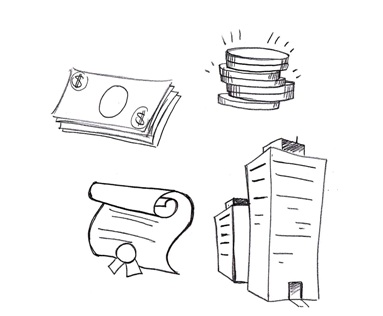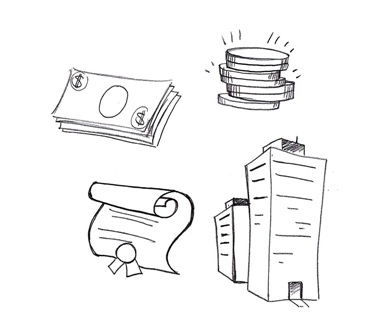The Golden Bucket of Savings

Once you have figured out how large your spending bucket needs to be, you can start to figure out the size of your saving and investment buckets.
You may be wondering what the difference is between saving and investing. To most people, they are the same. But I like to distinguish between them because I believe it will help you acquire wealth safely.
Saving and investing are the same in the sense that you are setting aside some portion of your current earnings for the future. The difference is, the purpose of saving is to safeguard that set-aside money, whereas the purpose of investing is to grow it.
The money in the savings bucket is money that I refer to as your SOA (start-over-again) fund–the money you put aside in case of a financial disaster. What if, for example, you woke up one day to find the company that has employed you for the last twenty years has shut its doors, and the pension plan it was holding for you is suddenly worthless?
You would have to start over, right? You’d need money to pay for your expenses while you found a new job, and you’d need money to start investing again. That’s why you need money in your savings bucket. And that money has to be absolutely safe.
Imagine how you would feel if you called up your broker to let him know that you needed to cash in your start-over-again fund and he told you its value had suddenly crashed and was now worth 10 cents on the dollar? Well, that’s exactly what happened to millions of Baby Boomers. The reason it happened is because these people did not distinguish between saving and investing. They had all their wealth tied up in investments advertised as safe, but were actually quite risky.
You don’t want to take any risk with your start-over-again money. The primary purpose of that money is to preserve, not increase, the capital you set aside. Putting it at risk, even average market risk, is too dangerous.
You need to be equally as careful with the money you set aside to repay debt. Because when the bill comes due, you must pay it. Keep that money safe. Put your debt obligations in your savings bucket, never into the market, even if the market looks safe.
Same is true of any future expenditure that is coming up relatively soon. By relatively soon, I mean, say, one business cycle–seven to ten years.
If, say, your retirement is still twenty or thirty years away, you can afford to invest money set aside for that purpose in vehicles that are safe, but not super-safe. However, if you will be retiring in less than ten years, you can’t take the chance of seeing your retirement fund drop by 20% to 30%, because you won’t have time to let the market correct itself.
So if you plan to retire in five years and you will be drawing on your retirement savings, you want to transfer at least five years’ worth of your retirement fund from your investing bucket to your savings bucket. To ensure that you will be able to pay for the retirement life you want, you can’t afford to have that money at risk.
Are you with me?
For your savings bucket, your money should only be in super-safe investments–investments that are highly unlikely to go down in value in the next ten years. Given today’s economy, we believe there are only four vehicles that qualify: cash, gold coins, quality municipal bonds, and well-bought rental real estate. For simplicity, my recommendation would be that you diversify your savings bucket funds evenly: 25% into each if you use four of them, 33% if you use three of them, or 50% if you use only cash and gold coins.

I will write about all four of these vehicles in future issues of The Palm Beach Letter. For now, it is enough for you to understand the distinction between saving and investing… and segregate your set-aside money accordingly.
I’ve already asked you to estimate your LBR (lifestyle burn rate). Now, I want you to estimate how much you’ll need in your savings bucket. That includes the money you would need in your SOA (start-over-again) funds if, for whatever reason, you lost everything. (I’ll be more specific about this number in an upcoming essay.) It also means identifying all of your debt obligations, and figuring out the totals of any future expenditures that will be coming due in the next ten years.
The Golden Bucket of Investing
As I said, the purpose of your investing bucket is to grow your wealth. This is the bucket you will use to fund all future, long-term expenditures. By “long-term,” I mean more than ten years.
If you are young, you may use this bucket to put aside money for your children’s college expenses. But for the most part, the money in this bucket will be for your retirement. And when you look at investment returns from a long-range perspective like that, even a few percentage points can make a huge difference.
I won’t spend any time here talking about how you should manage your investing, because Tom and Paul do that in The Palm Beach Letter. But I will say this: The kind of stocks they recommend are the only kind that appeal to me. Every other stock investing strategy I’ve encountered (and I’ve been in the financial publishing business for more than thirty years) makes me uncomfortable.
The recommendations that you get every month from Tom and Paul in The Palm Beach Letter are designed to give you an average, long-term return of 10%-15%. This might seem paltry to people who dream of doubling and tripling their money in the market every year, but those kinds of investors almost always end up broke. And making 10%-15% on your money over the long term will give you terrific results.
But–and this is a very big but–you won’t get wealthy this way unless you invest enough money.
In other words, investing alone can’t make you rich. So if you can afford to invest only a few thousand dollars a year, you will not get rich even if you make 15% a year for forty years. To fill your investing bucket, you need to invest more than that–and if you can’t invest more than that right now, you need to generate more income so you can.
That brings us back to the metaphorical well that represents your yearly income–the well you’re going to use to fill all three of your buckets.
Your Golden Well
If your income isn’t sufficient to fill all three buckets, you have only two options: You must increase the flow from the well you have, and/or you must dig some new wells.
You can increase the income from your primary well (your job) by becoming a more valuable employee. I have written on this subject in several of the books I published under the pen name Michael Masterson. The one I recommend is Automatic Wealth for Grads… and Anyone Else Just Starting Out.
If you can become a more valuable employee, you should. But you may also want to create other streams of income.
One possibility would be to invest in rental real estate. If you decide to do that, it will become–after you have paid down the mortgages–its own well, pumping liquid gold to you every year thereafter.
Another option would be to start a side business and let your spouse or a relative run it. If you are interested in doing that, I recommend Ready, Fire, Aim, another book I wrote as Michael Masterson.
The Palm Beach Income system could be another well for you in the future.

Here’s the point: If the income you are earning is insufficient to achieve your wealth-building goals, you should NOT try to get there by taking on more risk with your stocks. Instead, work hard to create more income.
The Only Strategy You Need
This simple system for managing money and building wealth can work for you if you commit yourself to it. As I said, it’s the system I used to build a net worth of more than $50 million–and it’s still working for me and everyone else I know who has tried it.
So today, spend the time it takes to establish your own approach to “living rich” now… and in the future. Make your spending bucket big enough to allow you to enjoy your life now, but small enough to enable you to fill up your saving and investing buckets quickly.
You don’t need to try any other wealth-building strategy. This one is infallible. The day you have your saving and investing buckets filled… you will have no reason to worry about money ever again.
You already know that it will work, don’t you? You know it will work because it is so simple. It is based on our two fundamental rules for building wealth: Never, ever lose money… and become wealthier every day.
If you are over forty, you have no doubt experienced how wrong 99% of the investment schemes out there are. You tried them and discovered they made you poorer, not richer. You are ready for something simple and true, a strategy you know in your bones will work.
When Tom and I started The Palm Beach Letter, we made a solemn promise. We vowed to tell the truth about building wealth, rather than exciting our readers with the myths and lies that dominate the investment media.
We are proud of what we are doing and confident that it will help you become wealthier. Our goal is not–and never will be–to make you a “clever” investor. We simply want to teach you how to become wealthy. If that’s what you want, you are in good company.
[Ed. Note: Mark Morgan Ford was the creator of Early To Rise. In 2011, Mark retired from ETR and now writes the Palm Beach Letter. His advice, in our opinion, continues to get better and better with every essay, particularly in the controversial ones we have shared today. We encourage you to read everything you can that has been written by Mark.]